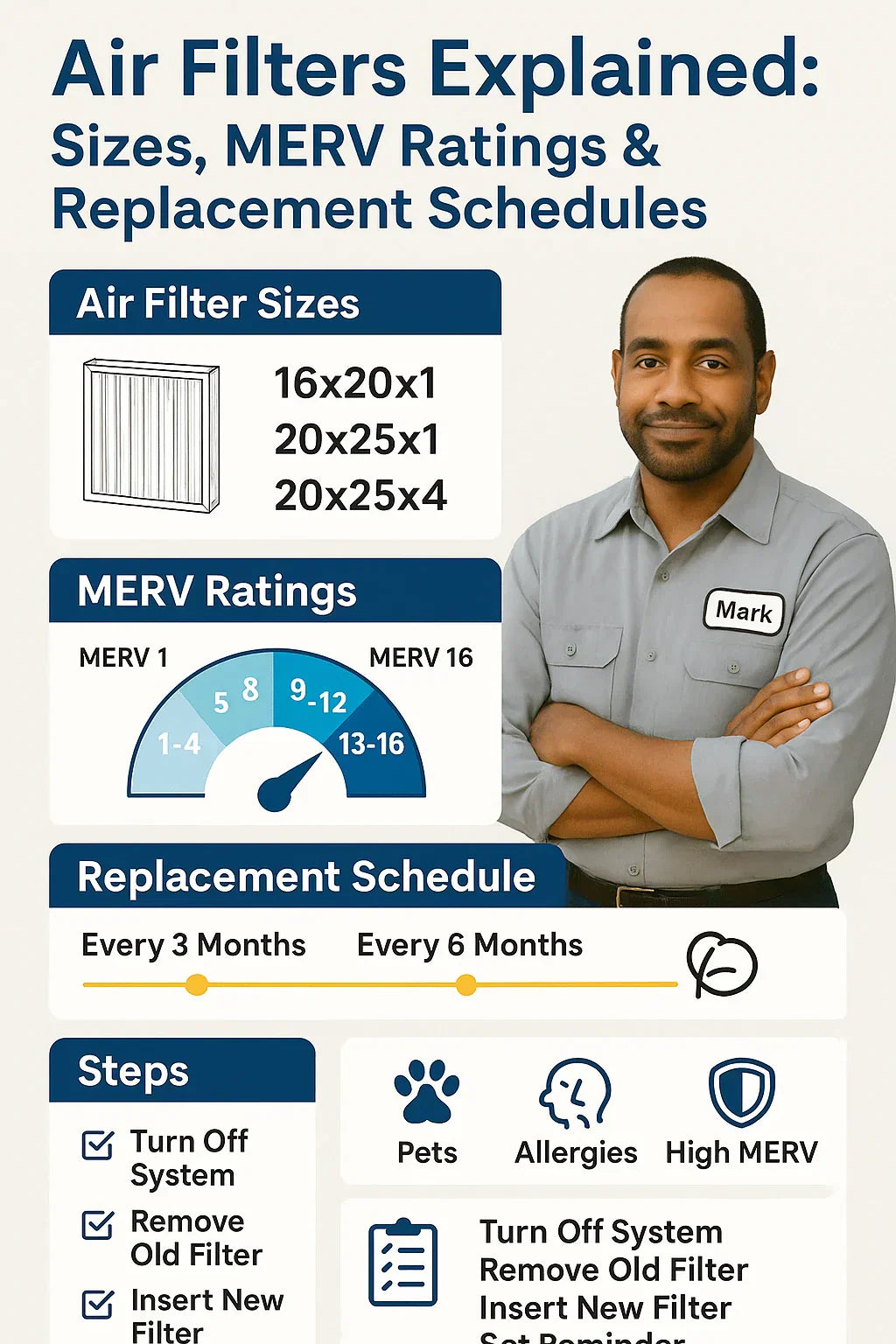🌀 Air Filters Explained: Sizes, MERV Ratings & Replacement Schedules
By Mark — Your Go-To DIY HVAC Guy
If there’s one thing I see homeowners underestimate time and time again, it’s the humble HVAC air filter. These little rectangles of fabric or pleats are the first line of defense for your system—and your lungs. Get it wrong, and you risk higher bills, poor air quality, and even a busted blower motor.
This guide covers everything you need to know—how to pick the right size, understand MERV ratings, and stick to a replacement schedule that works for your home. I’ll even throw in my personal filter hacks to make sure you never forget a change again.
📏 1. Understanding Air Filter Sizes
Before you even think about MERV ratings, you need to know what size filter your system takes.
An incorrectly sized filter can cause air leaks around the edges, letting dust bypass the filter entirely.
How to find your size:
-
Check your old filter — Most have dimensions printed on the frame (e.g., 16x25x1).
-
Measure your filter slot — If your old filter’s printing is faded, measure length × width × thickness (in inches).
-
Know nominal vs actual size — A “16x25x1” filter might actually measure 15.5" × 24.5" × 0.75". Filter packaging usually lists nominal size
Common residential sizes:
-
1-inch filters: 16x20x1, 20x20x1, 20x25x1
-
4-inch filters: 16x25x4, 20x25x4
-
5-inch filters: 20x25x5, 16x25x5 (Home Depot)
Mark’s Tip: If you have a hard-to-find size, consider a custom filter manufacturer. It’s better than forcing a “close enough” fit.
🛡️ 2. What is a MERV Rating?
MERV stands for Minimum Efficiency Reporting Value. It’s a scale from 1 to 20 that measures a filter’s ability to capture particles of varying sizes.
-
MERV 1–4: Captures large particles like dust, lint, and carpet fibers.
-
MERV 5–8: Captures mold spores, pet dander, and dust mites.
-
MERV 9–12: Adds pollen, lead dust, and auto emissions.
-
MERV 13–16: Traps bacteria, smoke, and some viruses.
-
MERV 17–20: HEPA-level filtration—usually for hospitals, cleanrooms.
Mark’s Take:
For most homes, MERV 8–13 is the sweet spot. Higher MERV filters trap smaller particles, but they can also restrict airflow if your system isn’t designed for them.
⚖️ 3. Balancing Filtration & Airflow
Too high of a MERV rating can choke your system’s airflow, forcing it to work harder and use more electricity.
How to check if your system can handle it:
-
Look in your HVAC manual or call the manufacturer.
-
Ask your tech during your next tune-up.
-
Monitor your system after switching to a higher MERV—listen for strain or check for reduced airflow at vents.
🐾 4. Special Considerations for Your Home
Your filter needs may change depending on your environment:
-
Pets: Go for MERV 8–11 to better capture dander and fur.
-
Allergies/Asthma: MERV 11–13 helps with pollen, mold, and fine dust.
-
Smokers: Higher MERV (13+) filters help capture smoke particles.
-
Construction Nearby: Upgrade temporarily during heavy dust conditions.
-
Wildfire Season: Consider MERV 13 or portable HEPA units indoors.
⏳ 5. Replacement Schedules
A dirty filter can cut your HVAC efficiency by 5–15% (U.S. Department of Energy). But how often should you change yours?
| Filter Type | MERV Range | Replacement Frequency |
|---|---|---|
| Fiberglass | 1–4 | Every 30 days |
| Pleated | 5–8 | Every 60–90 days |
| High-MERV | 9–12 | Every 60 days |
| MERV 13+ | 13–16 | Every 30–60 days |
| Washable | Varies | Every month (wash & dry fully) |
Mark’s Reminder Rule:
-
Pets or allergies? Cut those intervals in half.
-
Always replace before heavy-use seasons (summer & winter).
🧼 6. Disposable vs Washable Filters
Disposable Filters:
-
Pros: Convenient, consistent filtration, wide variety.
-
Cons: Ongoing cost, more waste.
Washable Filters:
-
Pros: Eco-friendly, reusable for years.
-
Cons: Lower MERV (often ≤8), must dry completely before reuse to avoid mold.
📋 7. Mark’s 5-Step Filter Swap Checklist
-
Turn off your system — Prevents unfiltered air from circulating.
-
Remove old filter — Note airflow direction arrow.
-
Clean slot — Vacuum out debris.
-
Insert new filter — Match airflow arrow with system direction.
-
Set a reminder — Phone calendar or sticky note inside the filter door.
🔄 8. Seasonal Strategy
I keep a year-round plan:
-
Spring: Fresh filter before AC season.
-
Summer: Mid-season swap.
-
Fall: Fresh filter before heating season.
-
Winter: Mid-season swap if needed.
This keeps both my energy bills and my allergies in check.
💡 9. Common Mistakes to Avoid
-
Using the wrong size — Air leaks reduce efficiency.
-
Letting filters go too long — Shortens equipment lifespan.
-
Using too high a MERV — Can strain blower motors.
-
Not sealing filter edges — Air bypass means dust bypass.
🛠 10. When to Call a Pro
-
Persistent dust problems even with regular filter changes.
-
Unusual noises from your blower.
-
Airflow drop after installing a higher MERV filter.
A tech can test static pressure and help you choose the safest, most effective filter.
✅ 11. Quick Reference Guide
| Situation | MERV Range | Change Every |
|---|---|---|
| No pets, no allergies | 6–8 | 90 days |
| Pets | 8–11 | 60 days |
| Allergies/asthma | 11–13 | 30–60 days |
| Smoker in home | 13+ | 30 days |
📌 12. Key Takeaways
-
Size matters — Always get the right fit.
-
MERV balance — Too high can hurt airflow.
-
Change regularly — Dirty filters cost money and comfort.
-
Match filter to your lifestyle — Pets, allergies, and local air quality matter.
In the next topic we will read more about: Why Your HVAC Needs a Drain Pan & How to Pick the Right One







